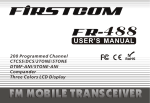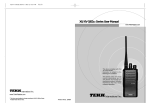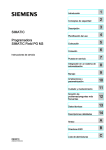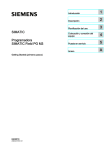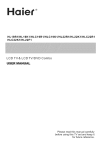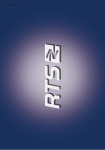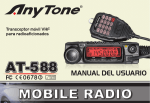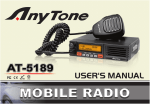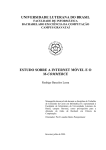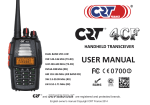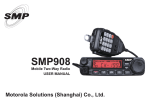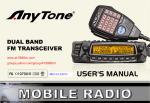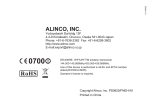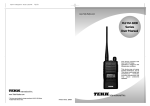Download DB477C - TDJ Australia
Transcript
1 DB477C Thank you for choosing this vehicle transceiver, always strives to provide high quality products, And this transceiver is no exception. As you learn how to use this transceiver, you will find that your unit is very user friendly. For example, each time you select a menu item, you will see a text message on the display that lets you know what you are configuring. Though it is user friendly, this transceiver is technically complicated and some features may be new to you. Consider this manual to be a personal tutorial from the designers, allow the manual to guide you through the learning process now, then act as a reference in the coming years. Precautions Please observe the following precautions to prevent fire, personal injury, or transceiver damage: Do not attempt to configure your transceiver while driving, it is dangerous. This transceiver is designed for a 13.8V DC power supply. Don't use a 24V battery to power on the transceiver. Do not place the transceiver in excessively dusty, humid or wet areas, nor unstable surfaces. Please keep it away from interferential devices (such as TV, generator etc.). 2 Do not expose the transceiver to long periods of direct sunlight nor place it close to heating appliances. If an abnormal odor or smoke is detected coming from the transceiver, turn OFF the power immediately. Contact a Crystal service agent or your dealer. CONTENTS New and Innovative Features...............................................5 Channel Delete................................................................................. 17 Supplied Accessories/Optional Accessories......................6 Shortcut Operations..............................................................18 Supplied Accessories........................................................................ 6 Squelch Off/Squelch Off Momentary................................................ 18 Initial Installation...................................................................7 Squelch Level Setup......................................................................... 18 Mobile Installation............................................................................. 7 DC Power Cable Connection............................................................ 8 Frequency/Channel Scan................................................................. 18 Channel Scan................................................................................... 18 Power Supply Voltage Display.......................................................... 10 CTCSS/DCS Encode and Decode Setup......................................... 18 Antenna Connection......................................................................... 10 CTCSS Scan..................................................................................... 19 Accessories Connections.................................................................. 11 DCS Scan......................................................................................... 19 Getting Acquainted...............................................................12 Compander (Decrease the background noise and enhance audio clarity...................................................................................................19 Front panel........................................................................................ 12 Rear panel........................................................................................ 13 Display.............................................................................................. 13 Microphone....................................................................................... 14 Amateur Transceiver Mode .......................................................15 Basic Operations ..................................................................16 Switching the Power On/Off ............................................................. 16 Adjusting the Volume ....................................................................... 16 Switch between VFO and Channel mode ........................................ 16 Adjusting Frequency/Channel Through Selector Knob..................... 16 Receiving.......................................................................................... 16 Transmitting...................................................................................... 16 Transmitting Tone-Pulse................................................................... 17 Transmitting Optional Signaling ....................................................... 17 Channel Edit..................................................................................... 17 Keypad Lockout................................................................................ 20 Current Voltage Enquiry.................................................................... 20 Auto-Dialer Setup.............................................................................. 20 Transmitting Edited DTMF Tones in the Auto-dialer Memory............ 20 General Setting......................................................................21 DTMF, DTMF ANI, 2Tone or 5Tone Signaling................................... 21 Sending 2-Tone Call.......................................................................... 21 Sending 5-Tone Call.......................................................................... 22 Sending DTMF call........................................................................... 22 Signaling Combination Setup............................................................ 22 TX OFF Setup................................................................................... 23 Busy Channel Lockout...................................................................... 23 Editing Channel Name...................................................................... 23 Reverse TX/RX................................................................................. 23 3 CONTENTS Talk Around....................................................................................... 24 TOT (Time-out timer)......................................................................... 30 Voice Compander ............................................................................ 24 CTCSS/DCS Encode and Decode.................................................... 31 Scrambler Setup (Encryption)........................................................... 22 Talk Around ...................................................................................... 31 Radio's DTMF SELF ID ENQUIRY .................................................. 24 Voice Prompt..................................................................................... 31 Radio's 5TONE SELF ID ENQUIRY ................................................ 25 LCD Backlight .................................................................................. 31 Voice Prompt..................................................................................... 25 Long-distance Anti-theft Alarm ...........................................32 TOT (Time-out timer)........................................................................ 26 APO (Auto power off)........................................................................ 26 DTMF Transmitting Time................................................................... 26 Squelch Level Setup......................................................................... 26 Scan Dwell Time Setup..................................................................... 27 LCD Backlight................................................................................... 27 4 Pilot Frequency................................................................................. 27 Display Mode Setup.......................................................................... 27 PIN Setup ......................................................................................... 28 Address List ..................................................................................... 28 Factory Default.................................................................................. 28 Microphone Operation..........................................................29 Function Setup By Microphone Keypad............................................ 29 Squelch Level................................................................................... 29 Optional Signaling ............................................................................ 29 Scan Skip ......................................................................................... 30 Frequency/Channel Scan ................................................................ 30 Busy Channel Lockout...................................................................... 30 Reverse TX/RX................................................................................. 30 Cable Clone ...........................................................................32 Maintenance...........................................................................33 Default Setting after Resetting.......................................................... 33 Trouble Shooting............................................................................... 33 Specifications........................................................................33 Attached Chart.......................................................................34 50 groups CTCSS Tone Frequency(Hz)........................................... 34 1024 groups DCS Code.................................................................... 34 Australian Broardcasting Requirements ...........................36 Transmit and Receive Procedure..................................................... 36 Radio Operation and EME Exposure............................................... 36 Electromagnetic Interference/Compatibility....................................... 36 Aircraft............................................................................................... 36 Medical Devices................................................................................ 36 General warnings.............................................................................. 37 Transmitting ..................................................................................... 37 Call Ring Tone................................................................................... 37 Roger Beep....................................................................................... 37 Duplex Operation Via Repeaters and Licence information...............38 New and Innovative Features DB477C Mobile Radio has a stylish and sturdy housing, advanced and reliable functions and is especially designed for drivers while pusuing the company philosophy of innovation and practicality. More functions as follows: Display on a large LCD with adjustable brightness, convenient for night-time use.. Buttons are distributed reasonably for convenient operation. Using superior quality material, better technology and high quality heatsink to ensure stable and durable operation. Programming different CTCSS, DCS, 2Tone, 5Tone in per channel, rejecting extra calling from other radios. Various scan functions including CTCSS/DCS Scan function. Using 5Tone to send Message, Emergency alarm, Call all, ANI, Remotely kill, Remotely Waken, etc. Automatic calling Identification function by DTMF--ANI or 5Tone-ANI . Scramble function (Optional). Compander function for decrease the background noise and enhance audio clarity, it can set compander ON/OFF per channel. Theft alarm provides extra safety. 5 Supplied Accessories/Optional Accessories Supplied Accessories After carefully unpacking the transceiver, identify the items listed in the table below. We suggest you keep the box and packaging. Transceiver DC Power Cable with Fuse Holder(QPL-01) Mobile Mounting Bracket (QMB-01) User Manual 6 Microphone (QHM-03) (with DTMF keyboard) Hardware Kit for Bracket Spare Fuses (one pair) [QF-01] Black screws Tapping screws S-Washer (M4X8mm) (M5X8mm) (QSS-01D) 4PCS(QSS-01A) 4PCS(QSS-01B) Initial Installation Mobile installation To install the transceiver, select a safe, convenient location inside your vehicle that minimizes danger to your passengers and yourself while the vehicle is in motion. Consider installing the unit at an appropriate position so that knees or legs will not strike it during sudden braking of your vehicle. Try to pick a well ventilated location that is shielded from direct sunlight. Determine the appropriate angle of the transceiver, using the 3 screw hole positions on the side of the mounting bracket. 1.Install the mounting bracket in the vehicle using the supplied selftapping screws (4pcs) and flat washers (4pcs). Car body Washer (M5) Tapping screw (M5x20mm) Mounting bracket 2.Position the transceiver, then insert and tighten the supplied hexagon SEMS screws. Double check that all screws are tightened to prevent vehicle vibration from loosening the bracket or transceiver. 7 Initial Installation DC Power Cable Connection Red Locate the power input connector as close to the transceiver as possible. Mobile Operation The vehicle battery must have a nominal rating of 12V. Never connect the transceiver to a 24V battery. Be sure to use a 12V vehicle battery that has sufficient current capacity. If the current to the transceiver is insufficient, the display may darken during transmission, or transmitting output power may drop excessively. 1.Route the DC power cable supplied with the transceiver directly Black 6.Connect the DC power cable to the transceiver's power supply connector. Press the connectors firmly together until the locking tab clicks. If the ignition-key on/off feature is desired (optional feature), use the to the vehicle's battery terminals using the shortest path from the transceiver. We recommend you do not use the cigarette lighter socket as some cigarette lighter sockets introduce an unacceptable voltage drop. 8 The entire length of the cable must be dressed so it is isolated from heat, moisture, and the engine secondary (high voltage) ignition system/ cables. 2.After installing cable, in order to avoid the risk of damp, please use heat-resistant tap to tie together with fuse box. Don't forget to reinforce whole cable. 3.In order to avoid the risk of short circuit, please remove negative (-) terminal of battery, then connect with radio. 4.Confirm the correct polarity of the connections, then attach the power cable to the battery terminals; red connects to the positive (+) terminal and black connects to the negative (-) terminal. Use the full length of the cable without cutting off excess even if the cable is longer than required. In particular, never remove the fuse holders from the cable. 5.Reconnect any wiring removed from the negative terminal. DC power cable Ext. Power jack optional 12V Plug cable. Connect one of the cables between the ACC terminal or a 12v Plug that operates with the vehicle ignition or ACC switch on the vehicle and EXT POWER jack on the rear side of the unit. In some cars,the 12V plug is always powered. If this is the case, you cannot use it for the ignition key on/off function. 7.When the ignition key is turned to ACC or ON(Start) position with the radio turned off, the power switch illuminates. The illumination will be turned off when the ignition key is turned to the off position. Initial Installation To turn on the unit, press the power switch manually while it is illuminated. (While ignition key is at ACC or ON position) 8.When the ignition key is turned to ACC or ON position with the radio's power switch on, the unit turns on automatically and the power switch will be lit. Turn the ignition key to OFF position or manually turn the power switch off to shut down the radio. 9.Using extra cable, power consumption:5MAH. Use the supplied DC power cable to connect the transceiver to a regulated power supply (not supplied). Do not substitute a cable with smaller gauge wires. Regulated power supply 10.Without this function, user can turn on/off radio by Power knob. ACC terminal 12V Plug connection Regulated power supply Black Red DC power cable with fuse holder (QPL-01) 2.Connect the transceiver's DC power connector to the connector on the DC power cable. Ext. Power jack Press the connectors firmly together until the locking tab clicks. Before connecting the DC power to the transceiver, be sure to switch the transceiver and the DC power supply OFF. Fixed Station Operation In order to use this transceiver for fixed station operation, you will need a separate 13.8V DC power supply (not included), power supply( QRP-01) as optional accessories. Please contact local dealer to require. The recommended current capacity of your power supply is 12A. 1.Connect the DC power cable to the regulated DC power supply and ensure that the polarities are correct. (Red: positive, Black: negative). Do not directly connect the transceiver to an AC outlet. Do not plug the DC power supply into an AC outlet until you make all connections. 9 Initial Installation REPLACING FUSES If the fuse blows, determine the cause, then correct the problem. After the problem is resolved, replace the fuse. If newly installed fuses continue to blow, disconnect the power cable and contact your authorized dealer or an authorized service center for assistance. Important The range of displayed voltage is only from 7V to16V DC, because the displayed value is estimated, please use a voltmeter when a more precise reading is desired. Antenna Connection 10 Fuse Location Transceiver Fuse Current Rating 15A Supplied Accessory DC power cable 20A Only use fuses of the specified type and rating, otherwise the transceiver could be damaged. If you use the transceiver for a long period when the vehicle battery is not fully charged, or when the engine is OFF, the battery may become discharged, and will not have sufficient reserves to start the vehicle. Avoid using the transceiver in these conditions. Power supply voltage Display After connecting the transceiver to the power supply, the supply voltage can be displayed on LCD by pressing the FUN key together with the key. The display immediately changes as the voltage supply changes, It also displays voltage during transmission. The transceiver will return to its normal operation when the power is switched ON or repeat above operation. Before operating, install an efficient, well-tuned antenna. The success of your installation will depend largely on the type of antenna and its correct installation. The transceiver can give excellent results if the antenna system and its installation are given careful attention. Use a 50Ω impedance antenna and low-loss coaxial feed-line that has a characteristic impedance of 50Ω, to match the transceiver input impedance. Coupling the antenna to the transceiver via feed-lines having an impedance other than 50Ω reduces the efficiency of the antenna system and can cause interference to nearby broadcast television receivers, radio receivers, and other electronic equipment. Transmitting without first connecting an antenna or other matched load may damage the transceiver. Always connect the antenna to the transceiver before transmitting. All fixed stations should be equipped with a lightning arrester to reduce the risk of fire, electric shock, and transceiver damage. The possible locations of antenna on a car are shown as following: Initial Installation Optional Accessory Connections External Speaker (not included) If you plan to use an external speaker, choose a speaker with an impedance of 8Ω. The external speaker jack accepts a 3.5mm (1/8") mono (2-conductor) plug. Microphone For voice communications, connect a microphone equipped with an 8-pin modular plug into the modular socket on the front of the main unit. Press firmly on the plug until the locking tab clicks. Attach the supplied microphone hanger in an appropriate location using the screws included in the screw set. Microphone connector External speaker adopt double port BTL, please care about the connecting way. The speaker can not connect with the ground, otherwise the speaker will be fault. The wrong connecting way as the following picture. 11 Microphone [QHM-03] Error Antenna (not included) Ground External speaker (not included) Getting Acquainted Front panel Press key. key until NO. KEY NO. KEY 1 Pow(Power) 2 VOL FUNCTION 4 FUN/SET Confirms the selective functions and exit 5 7 V/M/MW TS/DCS/LOCK Stores data into channels Sets Keypad lock function 9 SQL/D Compander mode on/off Press key and following key together to activate following function: Basic Functions 12 icon appears then press the following 3 Main Dial 4 FUN/SET 5 V/M/MW 6 7 8 9 MHz/SHIFT TS/DCS/LOCK CAL/H/L SQL/D FUNCTION Power on/Off Adjust Volume Key Change frequency, memory channel and scan direction etc. Function Key Switches between VFO mode and Channel mode Step Size Key ( step:1MHz) Sets CTCSS and DCS value Call key Squelch off 10 Data Terminal Data and Cloning port 11 12 TX Mic.connector lights during Transmitting Microphone connection port NO. 1 5 7 8 9 KEY Pow(Power) V/M/MW TS/DCS/LOCK CAL/H/L SQL/D FUNCTION Reset to factory default settings Erase the memory Auto dialer Enters clone data function mode Enters power supply voltage indication mode Functions that require continuous pressing following key to be activated NO. KEY 4 FUN/SET 9 SQL/D FUNCTION Press and hold for 2s to enter the Setting mode Monitor mode Getting Acquainted Rear panel 1 NO. KEY 3 2 1 SQL 2 M Indicates the channel number in channel mode. 3 NO. KEY 1 2 3 FUNCTION Terminal for connecting optional cable QCC01 for Ext. Power use with ignition key On/Off function. The radio will auto power on when car is driving. Jack The radio will auto power off when car stops. Ext.Speaker Terminal for optional external speaker SP01 Terminal Antenna Connection for 50Ω coaxial cable and antenna. Connector 12 10 11 Decimal point 6 8 2 4 5 6 7 Channel skip. Indicates the decimal point of frequency and the scanning function. Indicates the frequency or memory name. 7 Signal is being received or monitor. 8 Signal strength of receiving and transmitting. 9 Compander. Keypad lock . 10 11 12 13 19 9 1 3 5 15 15 13 14 13 19 4 Decimal point DCS +_ Set DCS function. Set CTCSS function. Offset frequency direction. Scramble. 14 DISPLAY FUNCTION Squelch level. In channel mode. A Auto power off. Pressing key. 13 Getting Acquainted microphone MIC Connector Diagram(in the front view of connector) Key Pad Serial Data +5V DOWN UP MIC GND MIC PTT GND NO. KEY 14 FUNCTION 1 UP Increase frequency, channel number or setting value. 2 DOWN Decrease frequency, channel number or setting value. 3 PTT Press the PTT (Push-TO-Talk) key to transmit. 4 Number Key Input VFO frequency or DTMF dial out etc.. 5 DTMF ON/ Switches between DTMF dialing or function operating. OFF 6 LOCK Switch Locks out the UP、Down、Numerical keys and Function keys. 7 MIC Speak here during transmission. PROFESSIONAL TRANSCEIVER MODE According to practical application, you can set the radio works in Professional Transceiver mode. There are 2 levels operation menu to set functions as you need. It is easy and convenient (From No.1 to No.15 are channel function setup, From No.15 to No.29 are general setting setup). A. Frequency + Channel mode: When set display as "FR", it enters into Frequency+Channel mode, new setting of channel operation and shortcut operation can be temporarily used by user. Once the radio is turned off or switched to another channel, the temporary setting will be erased and back to initial settings.(As pic 1) (Pic 1) B. Channel+Name Tag Mode: When set display as "NM", it enters into Channel+Name Tag mode. At this mode, it will display corresponding channel name when the current channel is edited with name. Otherwise, it will display frequency+channel. Its operations are the same as frequency + channel mode.(As pic 2) C. V F O M o d e ( F r e q u e n c y m o d e ) : This mode shows only frequency on the display. Shortcut operation and Channel setting will be changed & (Pic 3) stored as the latest value permanently. Once the radio is turned off or changed to new VFO frequency, the latest setting is remained until next change.(As pic 3) 1. Professional Transceiver Mode:When set display mode as "CH", it enters into Professional Transceiver mode.At this mode, except scan, other shortcut (Pic 4) operation can't operate. And from No.117 menu in function setting will be auto-hidden. If there is corresponding name for (Pic 5) current channel, the LCD will display current channel name Otherwise, it shows current channel number. (As pic 4) (As pic 5) Transceiver is programmed as professional transceiver mode. You can't change through manual operation from general setting. 4. Under every mode, from No.18-29 menu in general setting can be (Pic 2) changed and saved. 15 Basic Operations Switching The Power On/Off PWR KEY According to the option selected during installation Press the switch or turn the ignition key to ACC (speed up) or ON (startup) position to power on radio. Press the key for 1s or turn the ignition key to OFF position to turn off. Min Max Volume Volume Adjusting The Volume frequency in screen will be auto-hidden. In this status, turn selector knob or Microphone [ / ] key will increase or decrease frequency quickly by 1MHz step. 2.Under channel mode, you can change the current channel to the desired one through selector knob, clockwise turn to the forward channel, anticlockwise turn to the backward channel. In relative working mode, Microphone's [ / ] key has same function for adjusting frequency and channel. 5k, 6.25k, 8.33K,10k, 12.5k, 20k, 25k, 30k and 50k total nine step size available for this radio. Turn the VOL knob clockwise to increase the audio level, counterclockwise to decrease. Receiving During communication, volume can be adjusted more accurate. 16 Switch between VFO and Channel mode In standby, press key or Microphone's key until appear , this indicates current channel in channel mode. Repeat above operation to switch between Frequency mode (VFO) and Channel mode. If the transceiver has set at higher squelch level, it may fail to hear the calling. Adjusting Frequency/Channel THROUGH SELECTOR KNOB 1.Under frequency (VFO) mode, you can Frequency decrease change the current frequency to the desired one through selector knob; Turn clockwise to increase frequency; turn counterclockwise to decrease. Every gear will increase or decrease one step. Press key, the decimal point of When the channel you are operating is called, the screen shows and field intensity, in this way, you can hear the calling from transmitting party. Frequency increase When the channel you are operating is called, the screen shows BUSY and field intensity, you can't hear the calling from transmitting party, it means current channel receives a matching carrier but unmatching signaling(Refer to CTCSS/DCS encode and decode or Optional Signaling setup). Transmitting Press and hold Dial key or press MIC's key to monitor for a while to confirm the channel desired is not busy. Release or press Mic's key to return standby status, then press and hold [PTT] key to speak into microphone. Basic Operations Please hold the microphone approximately 2.5-5.0cm from your lips, and then speak into the microphone in your normal speaking voice to get best timbre. Press and hold [PTT] key, LED lights RED and power intensity showed in screen indicates it is transmitting, release to receive. Transmitting Tone-Pulse Press and hold [PTT] key, then press Microphone [ transmit current selected tone-pulse signal. Channel Delete 1.Under channel mode, turn selector knob to select channel which you want to delete. 2.Press key and key together, current channel will be deleted and emitted a prompt voice. icon flashing means current channel is deleted. ] key to Transmitting OPTIONAL SIGNALING Press and hold [PTT] key, then press Microphone key or press key in front panel or press Mic's key to transmit pre-stored and selected DTMF/2Tone/5Tone optional signaling. Channel Edit 1.Under frequency mode (VFO), turn selector knob to select the desired frequency or input frequency by MIC's numeric keys. 2.Press key to enter CTCSS/DCS signaling setup, turn selector knob to select the desired signaling. 3.Press key, LCD appears , icon and current channel number, icon flashing means current channel is empty. 4.Turn selector knob to select the desired channel number to store. key, , icon and channel number disappears and 5.Press emit a prompt voice, thus the channel storage succeed. 17 Shortcut Operations squelch off/squelch off momeNTARY key programmed as Squelch Off or Squelch Off Momentary to monitor the weak signal. 1.Squelch Off: Press key to disable squelch, press key again to resume squelch. 2.Squelch Off Momentary: Press and hold squelch, release key to disable key to resume squelch. The above functions should be set in programme software. Squelch level Setup Setting the radio to a tight squelch level, you can avoid unwanted signals or noise, but you may not receive a weak signal. Therefore, it will be 18 better for you to select the normal squelch level. key and turn 1.While standby, press selector knob until LCD appears and current squelch level. 2.Turn selector knob or press MIC [ / ] key to set desired squelch level. 3.Press any key except key to exit. and Frequency/Channel Scan Frequency Scan In frequency (VFO) mode, this function is designed to monitor signal of every communicative frequency point of transceiver "step size" you have set. 1.In VFO mode, press for 1s to enter into frequency scan. 2.Turn selector knob or press Microphone [ / ] key to change scan direction. 3.Press any key except and key to exit. Channel Scan In channel mode, this function is designed to monitor signal in every channel. key for 1s to enter into channel scan. 1.In channel mode, Press / ] key to 2.Turn selector knob or press Microphone [ change scan direction. 3.Press any key except and key to exit. CTCSS/DCS Encode and Decode setup Repeatedly press key to check whether set CTCSS/DCS encode and decode in current channel or not. 1.When LCD appears icon, it means current channel with CTCSS encode, turn selector knob or press Microphone's [ / ] key to select desired CTCSS encode. 2.When LCD appears and icon, it means current channel with CTCSS encode and decode, turn selector knob or press Microphone's [ / ] to select desired CTCSS code. Shortcut Operations 3.When LCD appears icon, it means current channel can be set with DCS encode and decode together, turn selector knob or press Microphone's [ / ] to select desired DCS encode and decode. 4.CTCSS:62.5-254.1, Total 51groups; DCS:000N-777I total 1024 groups. N is positive code, I is inverse code. 5.Press any key except , and keys to return into standby status. Under channel mode, this operation can be temporarily used by user. Once the radio is turned off or switched to another channel, the temporary setting will be erased. CTCSS SCAN Repeatedly press key until LCD displays and icons, then hold key for 1S to enter into CTCSS scanning. Once finding a matching CTCSS signaling, it will stop for 15s then scan again. DCS SCAN Repeatedly press key until LCD displays DCS icons, then hold key for 1S to enter into DCS scanning. Once finding a matching DCS signaling, it will stop for 15s then scan again. Compander (Decrease the background noise and ENHANCE AUDIO CLARITY) Compander function will decrease the background noise and enhance audio clarity, especially in long range communication. 1.Press key, then press key to turn on compander function, repeat above operation again to turn off compander function. icon, enable 2.When LCD appears compander in current channel. icon, disable compander in current 3.When LCD doesn't display channel. 19 Shortcut Operations KEYPAD LOCKOUT Avoiding unintentional operation, this function will lock main keys, all keys except 、 and key are invalid. 1. Press key until LCD displays icon, then press key until, LCD displays icon, it indicates keypad lockout function is valid. icon disappears, it indicates keypad 2. Repeat above operation, lockout function is invalid. Current Voltage ENQUIRY This function will display Current Battery Voltage. 20 1. Press and hold key, then press key, LCD displays current battery voltage. 2. Repeat above operation to return into VFO or Channel mode. In voltage display mode, all functions and channel or frequency selection are invalid. Auto-Dialer Setup This will automatically transmit pre-programmed and stored DTMF tones. And they are often used to remote control electronic devices or AUTOPATCH phone systems available on some repeater. 1. Press and hold key, then press key to enter the autodialer enquiry mode, LCD displays current default data and current group displayed on left. If no data in current group, it shows "EMPTY". 2. Turn selector knob to choose group you desired. Total:16 group, 01-16. 3. Press key to enter into editing of current group, press MIC's numeric keys to set your desired data. 4. The display scrolls when the 7th digit is entered. The numbers 0-9, --, A-D, * and # can be stored up to a total of 23 digits. 5. After editing, press PTT or key to send current group and store edited DTMF signaling. Press to exit and store. Transmitting Edited DTMF tones in the Auto-dialer memory 1. Press key, then press key to enter into auto-dialer enquiry 2. Turn selector knob to select desired transmitting group 3. Press PTT or key to transmit current selected DTMF tones. General Setting 1.Press and hold 2.Press or key for over 2s to enter general setting menu. to select the desired function option. 3.Turn selector knob to select the desired setup. to confirm and exit. 4.Press Meanwhile, if you want to edit channel name or start up menu, press or to move forward or backward, Press to store and exit. DTMF, DTMF ANI, 2Tone or 5Tone Signaling DTMF/5Tone/2Tone signalling function as similarily as CTCSS/DCS. Without receiving correspondent tone signalling, the speaker will remain mute. DTMF and 5Tone signalling can be applied for other advanced features such as ANI, PTT ID, group call, remotely stun, remotely kill, waken,...etc.. The signalling edition must be done through programming software. Please refer to the HELP option in the programming software to know how to operate these features. 1.Press and hold key for over 2s to enter into general setting menu. 2.Press / to choose No.2 menu, LCD displays "T-OFF". 3.Turn selector knob to select the desired setup. "DTMF": The channel will be mute by a DTMF signal. The speaker won’t be open until receiving a correspondent DTMF signal. Hold "PTT" then press [UP] or press directly to transmit the pre-stored DTMF signaling. In DTMF signaling mode,press for 2s until LCD displays "AN---", turn selector knob to select desired digit (the other party ID).In this mode, press to confirm exist digit and move cursor to next, press to forward cursor.After editing, press key to operate ANI call. "2TONE": The channel will be mute by a 2-Tone signal. The speaker won’t be open until receiving a correspondent 2-Tone signal. Hold "PTT" then press [UP] or press "5Tone": The channel will be mute by a 5-Tone signal. The Speaker won’t be open until receiving a correspondent 5-Tone signal. Hold "PTT" then press [UP] or Press In 5Tone signaling mode, press for 2s until LCD displays "AN---", turn selector knob to select desired digit(caller ID). In this mode, press to confirm exist digit and move cursor to next, press to forward cursor.After editing, press key to operate ANI call. 5.Press key to confirm and exit. Sending 2-Tone Call 1.Press and hold key for over 2s to enter general setting menu. 2.Press / key to choose No.03 menu, LCD displays "2TON XX", "XX" indicates the group in the list. 3.Turn selector knob to select the desired sending 2TONE group, Press PTT to transmit selected group. 4.Total: 32groups, 00-31, Default: 00. 5.Press key to confirm and exit. 21 General Setting Content and name of 2TONE will be edited by programming software. This radio only query edited group or name. If there is corresponding name for 2TONE, this operation will display 2TONE corresponding name. Sending 5-Tone Call 1.Press and hold key for over 2s to enter general setting menu 2.Press / key to choose No.04 menu, LCD displays "5TON XX", "XX" indicates the group in the list. 3.Turn selector knob to select the desired sending 5TONE group, 22 Press PTT to transmit selected group. 4.Total:100groups, 00-99, Default:00. 5.Press key to confirm and exit. Sending DTMF call 1.Press and hold key for over 2s to enter general setting menu. 2.Press / key to choose No.05 menu, LCD displays "DTMF XX", "XX" indicates the group in the list. 3.Turn selector knob to select the desired sending DTMF group, Press PTT to transmit selected group. 4.Total: 16groups, 00-16, Default: 00. key to confirm and exit. 5.Press Signaling Combination setup This function is used to prevent the radio from receiving irrelevent signals. 1.Press and hold key for over 2s to enter general setting menu. 2.Press / key to choose No.06 menu, LCD displays "SPK--SQ". 3.Turn selector knob to select the desired combination. If select "SQ", it indicates you can hear the calling from caller when receive a matching carrier. If LCD displays "CTC", it indicates you can hear the calling from caller when receive a matching carrier and CTCSS/DCS signaling. If LCD displays "TON", it indicates you can hear the calling from caller when receive a matching carrier and DTMF/2TONE/5TONE signaling. If LCD displays "C T", it indicates you can hear the calling from caller when receive a matching carrier and CTCSS/DCS and If LCD displays "C/T", it indicates you can hear the calling from caller when receive a matching carrier and either CTCSS/DCS and DTMF/2TONE/5TONE signaling. 4.Press key to confirm and exit. This setting will be set together with adding optional signaling and CTCSS/DCS. General Setting TX OFF SETUP Disable this function, it is invalid to press PTT, current channel only works in RX mode. 1.Press and hold 2.Press / key for over 2s to enter general setting menu. key to choose No.09 menu, LCD displays "TX- ON". 3.Turn selector knob to select the desired setting. ON: In current channel, Press PTT to transmit. OFF: In current channel, Press PTT is invalid. key to confirm and exit. 4. Press Default:ON. Busy Channel Lockout BCLO is to disable transmitting while RX signal is received. Once the channel is busy and you press PTT, the radio will beep as warning and get back to receiving. 1.Press and hold key for over 2s to enter general setting menu. / key to choose No.10 2.Press menu, LCD displays "LOCK--OFF". 3.Turn selector knob to select the desired setting. BU: Enable BCLO, Carrier lockout, transmitting is inhibited when current channel receives a matching carrier; press [PTT] to emit error voice prompt and back to receiving status. RL: Enable BTLO, transmitting is inhibited when current channel receives a matching carrier but dismatching CTCSS/DCS. Press [PTT] to emit error voice prompt and back to receiving status. OFF: Busy channel lockout is disabled.It can transmit in any receiving status. 4.Press key to confirm and exit. Editing Channel NAME 1.Press and hold key for over 2s to enter general setting menu. 2.Press / key to choose No.11 menu, LCD displays cursor and flashing. 3.Turn selector knob to select the desired letter, press key to 4.confirm selected letter and enter into next edition, Press 5.to return forward edition. key to exit. 6.After edition, press In Frequency (VFO) mode, this function will be auto-hidden. Reverse TX/RX TX frequency turns to RX frequency & RX frequency changes to TX frequency. The signaling will also be reversed if CTCSS/DCS signaling exited in this channel. 1.Press and hold 2.Press / key for over 2s to enter general setting menu key to choose No.12 menu, LCD displays "REV—OF". 3.Press key to confirm and exit. 23 General Setting 1.Turn selector knob to select the desired setting. ON: Enable Frequency Reverse OFF: Disable Frequency Reverse. 2.After edition, press key to exit. Talk Around By Talk Around function, you can directly communicate with other radios the repeater range. The transceiver will transmit by RX frequency with its CTCSS/DCS signaling. 1.Press and hold key for over 2s to enter general setting menu. 2.Press 24 / key to choose No.13 menu, LCD displays "TALK—OF". 3.Turn selector knob to select the desired setting. ON: Enable Talk Around OFF: Disable Talk Around 4.After edition, press key to exit. Voice Compander Enable this function to reduce background noise and enhance audio clarity, especially in long range communication. 1.Press and hold 2.Press / "COMP--OF". key for over 2s to enter general setting menu key to choose No.14 menu, LCD displays 3.Turn selector knob to select the desired setting. ON: Enable compander OFF: Disable compander 4.Press key to confirm and exit. 5.Default:OFF Scrambler setup (Encryption) An analog voice inversion scrambler can be equipped as optionals. This special audio process can offer a more confidential communication. Other radios at same frequency will receive only disordered noises. 1.Press and hold key for over 2s to enter general setting menu. 2.P r e s s / key to choose No.15 menu, LCD displays "SCR-OF". 3.Turn selector knob to select the desired setting. ON:Enable Scrambler OFF:Disable Scrambler 4.Press key to confirm and exit.Default:OFF. This function is optional. Radio's DTMF SELF ID ENQUIRY 1. Press and hold key for over 2s to enter general setting menu. 2.Press / key to choose No.16 menu, LCD displays "D--XXX", "XXX" is radio's DTMF SELF ID. 3.Press key to confirm and exit. General Setting Radio's 5TONE SELF ID ENQUIRY 1.Press and hold key for over 2s to enter general setting menu. 2.Press / key to choose No.17 menu, LCD displays "F-XXXXX", "XXXXX" is radio's 5TONE SELF ID. 3.Press key to confirm and exit. Voice Prompt The prompting tone provides confirmation of entry, error status or malfunctions of the transceiver. You can enable or disable this function. 1.Press and hold key for over 2s to enter general setting menu. 2.Press / key to choose No.18 menu, LCD displays "BEEP-ON". 3.Turn selector knob to select the desired setting. ON: Enable voice prompt OFF: Disable voice prompt 4.Press key to confirm and exit. Default:ON. Suggestion:Enable this function to check incorrect operation and malfunctions. 25 General Setting TOT (Time-out timer) The time-out timer limits the amount of transmitting time. When you reach the time limit which has been programmed by your dealer, your transmission will be cut off. In order to transmit again, you must release PTT button to reset the timer. 1.Press and hold key for over 2s to enter general setting menu. 2.Press / key to choose No.19 menu, LCD displays "TOT--3". 3.Turn selector knob to select the desired setting. Timer: 1-30min, each level 1min OFF: Disable TOT 26 4.Press key to confirm and exit. Default:3. APO (Auto power off ) Once APO is activated, the radio will be automatically switched off when the pre-set timer is running to end. key for over 2s to enter general 1.Press and hold 2.setting menu. 3.Press / key to choose No.20 menu, LCD displays "APO--OFF". 4.Turn selector knob to select the setting. 30MIN: Auto power off after 30m 1HOUR: Auto power off after 1h 2HOUR: Auto power off after 2h OFF: Disable Auto power off 5.Press key to confirm and exit.Default:OFF DTMF Transmitting Time 1.Press and hold key for over 2s to enter general setting. 2.Press / key to choose No.21 menu, LCD displays "SPD--50". 3.Turn selector knob to select the desired setting. 30/50/100/200/300/500, which indicates the time for sending each DTMF signal & the interval between each DTMF being sent. 4.Press key to confirm and exit. Default:50MS. Squelch level Setup Setting the radio to a tight squelch level, you can avoid unwanted signals or noise, but you may not receive a weak signal. Therefore, it will be better for you to select the normal squelch level 1.Press and hold key for over 2s to enter general setting menu. / key to choose No.22 2.Press menu, LCD displays "SQL--04". 3.Turn selector knob to select the desired squelch level. OF-20 total 21, OF is min setting value(ON) 4.Press Press level. key to confirm and exit. Default:04 , then turn selector knob also can select the desired squelch If the transceiver has set at higher squelch level, it may fail to hear the calling.If set at lower squelch level, the radio will be interfered. General Setting Scan Dwell Time Setup There are 3 kinds of Scan Dwell Time for option. 1.Press and hold key for over 2s to enter general setting menu. 2.Press / key to choose No.23 menu, LCD displays "SCAN--TO". 3.Turn selector knob to select the desired Scan Dwell Time. TO:It pauses 15s once scanning a matching signal, then resume scan. CO:It pauses once scanning a matching signal, signal disappeared then resume scan. SE:It stops once scanning a matching signal. key to confirm the selection and exit. 4.Press Default:TO. LCD Backlight 1.Press and hold key for over 2s to enter general setting menu. 2.Press / key to choose No.24 menu, LCD displays "LAMP--25". 3.Turn selector knob to select the desired LCD backlight brightness 1-32 total 32 level backlight brightness. key to confirm and exit. Default:25. 4.Press Pilot Frequency This function uses to start repeater. It needs a certain intensity Pilot Frequency to start dormant repeater. As usual, no need to send pilot frequency again once repeater started. 1.Press and hold key for over 2s to enter general setting. 2.Press / key to choose No.25 menu, LCD displays "TB-1750". 3.Turn selector knob to select the desired pilot frequency. 1750HZ:Pilot frequency1750HZ 2100HZ:Pilot frequency 2100HZ 1000HZ:Pilot frequency 1000HZ 1450HZ:Pilot frequency 1450HZ key to confirm the 4.P r e s s selection and exit. Default:1750HZ Display Mode Setup There are 3 different dispaly modes: Frequency+Channel mode, & Channel mode&Channel+Name Tag mode. 1.Press and hold key for over 2s to enter general setting menu. 2.Press / key to choose No.26 menu, LCD displays "DSP—FR". 27 General Setting 3.Turn selector knob to select the desired mode. FR:Frequency+Channel mode(Amateur transceiver mode). CH:Channel mode(Professional transceiver mode). NM:Channel+Name Tag mode(Amateur transceiver mode), ifchannel not named, it displays Frequency+Channel mode. 4.Press key to confirm and exit. Default:FR. PIN Setup Enable this function, you have to insert a matching PIN to enter into normal status when radio is turned on.(Pin setup by programme software). 1.Press and hold menu. 28 key for over 2s to enter general setting 2.Press / key to choose No.27 menu, LCD displays "CODE-OF". 3.Turn selector knob to enable/disable Pin setup. ON: Turn on Pin setup OFF:Turn off Pin setup key to confirm and exit.Default:OFF 4.Press Address list You store desired ID and corresponding ID name in address list. The LCD displays ID corresponding name if radio received ANI calling and find matching ID in address list. 1. Press and hold 2.Press "BOOK". / key for over 2s to enter general setting menu. key to choose No.28 menu, LCD displays 3.Press to enter into ID setting, press / to select the desired group (00-127, total is 128 group ID). Turn selector knob to select desired number, press confirm and move cursor to next edition, press to clear out all digits. 4.A f t e r f i n i s h i n g e d i t i o n , p r e s s t o confirmand enter into edition of current group's ID corresponding name.Turn selector knob to select desired letter, press to move cursor to next edition, Press to clear out all letters. 00-127, total 128 group ID and corresponding ID name. to confirm and return into main menu. Repeat above 5. Press Step 3 and Step 4 operations to edit multi-ID and corresponding ID name. 6.Press key to return into standby status. Factory Default If your radio seems to be malfunctioning, resetting the microprocessor may solve the problem. When performing the reset, you may lose memory data and stored information. Back up or write down important data before performing the reset. 1.Press and hold key for over 2s to enter general setting menu. 2.Press / key to choose No.29 menu, LCD displays "RESTORE". 3.Turn selector knob to select the desired operation. FACT:Resume factory default for channel, signaling and general setting . SETUP:Return initial setup for No.18-No.27 general settings menu Press to confirm general setting Microphone Operation Switches between VFO and channel mode UP DOWN In standby, press key to switch between channel mode and Frequency mode (VFO). PTT Numeric Keys Lock DTMF ON/OFF Speaker You can operate the transceiver by keypad or input desired frequency or channel through the QHM-03 microphone (Note:In professional transceiver mode, other keys are invalid except PTT, [ / ], and ). Keypad Lock Pull down the slide switch to lock position, the lamp is turned off and all of keypads is not work except PTT switch. Transmitting DTMF By Microphone KeyPAD Slide DTMF key to DTMF position, press and hold the [PTT] key, transmitting the desired DTMF signaling by the numeric key directly. (Note:Slide DTMF key to DTMF position, the keyboard is invalid in standby). Function Setup By Microphone Keypad Short Calling In standby, press to transmit the selected DTMF/2TONE/5TONE in current channel. , LCD displays DTMF Transmitting DTMF Code:In standby, press data and group. Press [ / ] key to select the desired transmitting DTMF group, then Press PTT to transmit. If no DTMF data in current group, LCD displays "EMPTY", press key again and input desired DTMF code by keypad, press PTT to transmit and store DTMF data. Squelch Level 1. In standby, press , then press , LCD displays "SQL" and 29 current squelch level. / to adjust the desired squelch level. (press 2. Press , then press , turn selector knob also can adjust the desired squelch level. 3. Optional signaling In standby, press , then press to add optional signaling, repeat above operation to set DTMF, 2TONE or 5TONE signaling. displays "D", it indicates DTMF function enable. displays " T", it indicates 2Tone function enable. Microphone Operation When first bit of Exa byte in frequency displays "F", it indicates 5Tone function enable. This function can be temporarily used in channel mode. Once the radio is turned off or switched to another channel, the temporary setting will be erased and back to initial settings. Scan Skip In Channel mode, press then press , decimal point displayed between frequency's ten digit and unit digit, it means current channel is scan skip. Repeat above operation to set scan or scan skip in current channel. 1.decimal point displayed between frequency's ten digit and unit digit, it means current channel is scanned skip. 2.decimal point is not displayed between frequency's ten digit and unit digit, it means current channel is scanned. 30 Frequency/Channel scan In corresponding mode, press scanning. In scanning mode, press / then press key to enter into to change scan direction. Busy Channel Lockout BCLO is to disable transmitting while RX signal is received. Once the channel is busy and you press PTT, the radio will beep as warning and get back to receiving. 1.In standby, press Channel Lockout. 2.Press [ / , then press to enter into Busy ] to select the desired value. BU: Enable BCLO, Carrier lockout, transmitting is inhibited when current channel receives a matching carrier; press [PTT] to emit error voice prompt. RL: Enable BTLO, transmitting is inhibited when current channel receives a matching carrier but dis-matching CTCSS/DCS. Press [PTT] to emit error voice prompt It can transmit in any receiving status. OFF: Busy channel lockout is disabled. 3.Press number keys to confirm and exit. This function can be temporarily used in Channel mode. Once the radio is turned off or switched to another channel, the temporary setting will be erased and back to initial settings. Reverse TX/RX TX frequency turns to RX frequency & RX frequency changes to TX frequency. The signaling will also be reversed if CTCSS/DCS signaling exited in this channel. 1.In standby, press / 2.Press [ , then press , LCD displays "REV—ON" ] to select the desired value. ON:Enable Frequency Reverse OFF:Disable Frequency Reverse 3.Press number keys to confirm and exit. This function can be temporarily used in Channel mode. Once the radio is turned off or switched to another channel, the temporary setting will be erased and back to initial settings. TOT (Time-out timer) The time-out timer limits the amount of transmitting time. When you reach the time limit which has been programmed by your dealer, your transmission will be cut off. In order to transmit again, you must release PTT button to reset the timer. 1.In standby, press , then press LCD displays "TOT-X". / ] to select the desired value. 2.Press [ Press number key to confirm and exit. 3. CTCSS/DCS Encode and Decode 1.In standby, press Encode and Decode. , then press to enter into CTCSS/DCS 2.Repeat above operation to set as below: LCD displays icon, it indicates CTCSS encode set in current channel. and icon, it indicates CTCSS encode and LCD displays decode set in current channel. LCD displays DCS icon, it indicates DCS encode and decode set in current channel. 3.In corresponding icon, press [ CTCSS/DCS encode and decode. 4.Press , , or / ] to select the desired to confirm and exit. This function can be temporarily used in Channel mode. Once the radio is turned off or switched to another channel, the temporary setting will be erased and back to initial settings. / ] to select the desired setting. ON:Enable Talk Around OFF:Disable Talk Around 3.Press number key to confirm and exit. This function can be temporarily used in Channel mode. Once the radio is turned off or switched to another channel, the temporary setting will be erased and back to initial settings Voice Prompt The prompting tone provides confirmation of entry, error status or malfunctions of the transceiver. You can enable or disable this function. , then press , LCD displays "BEEP--XX". 31 1.In standby, press / ] to turn on/off BEEP voice prompt. 2.Press [ BEEP—OF: turn off voice prompt BEEP—ON: turn on voice prompt 3.Press number key to exit and store. LCD Backlight Talk Around By Talk Around function, you can directly communicate with other radios in your group in case the repeater is not activated or when you are out of the repeater range. The transceiver will transmit by RX frequency with its CTCSS/DCS signaling. 1.In standby, press 2.Press [ , then press key, LCD displays "TALK--OF". 1.In standby status, press XX". 2.Press [ , then press LCD displays "LAMP- / ] to select desired backlight brightness(1-32 levels). 3.Press number keys to confirm and exit. Long-distance Anti-theft Alarm This function is mainly use for simple anti-theft alarm device in vehicles. When the transceiver be removed in an improper manner, the transceiver will emit and transmit alarming and background voice to system and other transceiver of the same frequency. DC power cable Alarm cable [QL-01(A)] 3.When the alarm cable QL-01(A) or QL-01(B) is removed from the DATA jack or cut by improper sequence, the alarm function enable and will alarm as programmed. In alarming, the transceiver will stop alarm once receiving a matching signal. And alarm again when a matching signal disappeared. 4.Restart radio to cancel anti-theft alarming.Reconnect with alarm cable and turn off radio, the system will return to alarm mode. Cable Clone Battery Steering-wheel etc. This feature will copy the programmed data and parameters in the master unit to slave units. It copies the parameters and memory program settings. 1.Use optional CP50 cloning cable, connect the cable between the data jacks on both master and slave. 2.Press and hold key, then press mode, LCD displays "CLONE". 32 Alarm cable [QL-01(B)] Connect DC power cable with car battery. 1.Connect the optional alarm cable QL-01(A) to the data jack on the front panel as shown. Secure the other end of the cable to an object that stays fixed in vehicle. (Note: if alarm cable QL-01 (A) is not enough long, you can choose optional alarm cable QL-01 (B) to extend). 2.When transceiver power off by press key, the long-distance anti-theft alarm enable. The long-distance anti-theft alarm only available when transceiver power off. Master/Slave stereo plug,3.5mm plug GND key to enter into cloning DATA TX/RX 3.Press master unit's [PTT] key, LCD displays "SD XXX", "XXX" indicates data volume in transmitting. Slave unit displays "LD XXX", "XXX" indicates received data volume. When the transmission is successfully finished, the master and slave unit both display "PASS". Turn off the power, disconnect the cable and repeat step 2 to step 3 operations to clone the next slave unit. If the data is not successfully transmitted, turn off both units, make sure the cable connection is correct and repeat the entire operation from the beginning. Maintenance Default Setting after Resetting General Frequency Range UHF CB: 476.4250~477.4125MHz DB477C DCS encode and decode - Channel Spacing 12.5K VFO frequency 477.00MHz DCS code 023N Phase-locked Step Memory channel 0-199 OFF 5KHz, 6.25KHz, 8.33KHz, 10KHz, 12.5KHz, 15KHz, 20KHz, 25KHz, 30KHz, 50KHz TOT OFF Operating Voltage 13.8V DC ±15% Channel Step 12.5 Key-lock setting APO OFF Squelch Carrier/CTCSS/DCS/5Tone/2Tone/DTMF CTCSS encode and decode - Squelch Level 4 CTCSS tone frequency 88.5Hz Offset direction Trouble Shooting Problem Possible Causes and Potential Solutions (a) Power is on, nothing appears on Display. + and - polarities of power connection are reversed. Connect red lead to plus terminal and black lead to minus terminal of DC power supply. (b) Fuse is blown. Check and solve problem resulting in blown fuse and replace fuse with new fuse. (c) Display is too dim. Dimmer setting is "LAMP-L". Please make the dimmer setting "LAMP-H". (d) No sound comes from speaker. • Squelch is muted. Decrease squelch level. • Tone or CTCSS/DCS squelch is active. Turn CTCSS or DCS squelch off. (e) Key and Dial do not function. Key-lock function is activated. Cancel Key-lock function. (i) Rotating Dial will not change memory channel. Transceiver is in CALL mode. Press the VFO or memory mode. (g) PTT key is pressed but transmission does not occur. • Microphone connection is poor. Connect microphone properly. • Antenna connection is poor. Connect antenna properly. Frequency Stability ±2.5ppm Operating Temperature -20℃~+60℃ Dimensions(WxHxD) 145 (W) x 47 (H) x 190 (L)mm Weight about 1.2Kg Receiver (ETSI EN 300 086 standard testing ) Sensitivity (12dB Sinad) Adjacent Channel Power ≤0.35μV ≥60dB Spurious Emission ≥70dB Hum & Noise Audio distortion technology. Power Output Modulation ≥60dB Intermodulation Audio Response Transmitter (ETSI EN 300 086 standard testing ) +1~-3dB (0.3~2.55KHz) ≥40dB ≤5% 5W 11KΦF3E Adjacent Channel Power ≥60dB Hum & Noise ≥36dB Spurious Emission ≥60dB Audio Response +1~-3dB (0.3~2.55KHz) Audio Distortion ≤5% 33 15 Attached Chart 50 groups CTCSS Tone Frequency(Hz) 67.0 79.7 94.8 110.9 131.8 156.7 171.3 186.2 203.5 229.1 69.3 82.5 97.4 114.8 136.5 159.8 173.8 189.9 206.5 233.6 71.9 85.4 100.0 118.8 141.3 162.2 177.3 192.8 210.7 241.8 74.4 88.5 103.5 123.0 146.2 165.5 179.9 196.6 218.1 250.3 77.0 91.5 107.2 127.3 151.4 167.9 183.5 199.5 225.7 254.1 34 1024 groups DCS Code. 000 010 020 030 040 050 060 070 100 110 120 130 140 150 160 170 200 210 220 230 240 250 260 270 300 310 001 011 021 031 041 051 061 071 101 111 121 131 141 151 161 171 201 211 221 231 241 251 261 271 301 311 002 012 022 032 042 052 062 072 102 112 122 132 142 152 162 172 202 212 222 232 242 252 262 272 302 312 003 013 023 033 043 053 063 073 103 113 123 133 143 153 163 173 203 213 223 233 243 253 263 273 303 313 004 014 024 034 044 054 064 074 104 114 124 134 144 154 164 174 204 214 224 234 244 254 264 274 304 314 005 015 025 035 045 055 065 075 105 115 125 135 145 155 165 175 205 215 225 235 245 255 265 275 305 315 006 016 026 036 046 056 066 076 106 116 126 136 146 156 166 176 206 216 226 236 246 256 266 276 306 316 007 017 027 037 047 057 067 077 107 117 127 137 147 157 167 177 207 217 227 237 247 257 267 277 307 317 Attached Chart 320 330 340 350 360 370 400 410 420 430 440 450 460 470 500 510 520 530 540 550 560 570 600 610 620 630 640 650 660 670 321 331 341 351 361 371 401 411 421 431 441 451 461 471 501 511 521 531 541 551 561 571 601 611 621 631 641 651 661 671 322 332 342 352 362 372 402 412 422 432 442 452 462 472 502 512 522 532 542 552 562 572 602 612 622 632 642 652 662 672 323 333 343 353 363 373 403 413 423 433 443 453 463 473 503 513 523 533 543 553 563 573 603 613 623 633 643 653 663 673 324 334 344 354 364 374 404 414 424 434 444 454 464 474 504 514 524 534 544 554 564 574 604 614 624 634 644 654 664 674 325 335 345 355 365 375 405 415 425 435 445 455 465 475 505 515 525 535 545 555 565 575 605 615 625 635 645 655 665 675 326 336 346 356 366 376 406 416 426 436 446 456 466 476 506 516 526 536 546 556 566 576 606 616 626 636 646 656 666 676 327 337 347 357 367 377 407 417 427 437 447 457 467 477 507 517 527 537 547 557 567 577 607 617 627 637 647 657 667 677 700 710 720 730 740 750 760 770 701 711 721 731 741 751 761 771 702 712 722 732 742 752 762 772 703 713 723 733 743 753 763 773 704 714 724 734 744 754 764 774 705 715 725 735 745 755 765 775 706 716 726 736 746 756 766 776 707 717 727 737 747 757 767 777 N is positive code, I is negative code, total: 232groups. 35 Australian Broardcasting Requirements Transmit and Receive Procedure Your two-way radio contains a transmitter and a receiver. To control your exposure and ensure compliance with the general population/ uncontrolled environment exposure limits, always adhere to the following procedure: • Transmit no more than 50% of the time. • To receive calls, release the PTT button. • To transmit (talk), press the Push to Talk (PTT) button. Transmitting 50% of the time, or less, is important because the radio generates measurable RF energy exposure only when transmitting (in terms of measuring standards compliance). Radio Operation and EME Exposure 36 Unauthorised antennas, modifications, or attachments could damage the radio and violate compliance. Do NOT hold the antenna when the radio is “IN USE.” Holding the antenna reduces the effective range. Do not use the radio if the antenna is damaged. If a damaged antenna makes contact with your skin, a minor burn can result. Electromagnetic Iterference/Compatability Nearly every electronic device is susceptible to electromagnetic interference (EMI). To avoid the possibility of electromagnetic interference and/or compatibility conflicts, turn off your radio in any location where posted notices instruct you to do so such as health care facilities. Aircraft When instructed to do so, turn off your radio when onboard an aircraft. Any use of a radio must be in accordance with applicable regulations per airline crew instructions. Medical Devices Pacemakers The Advanced Medical Technology Association recommends that a minimum separation of 6 inches (15cm) be maintained between a radio and a pacemaker. These recommendations are consistent with the independent research by and recommendations of the U.S. Food and Drug Administration. People with pacemakers should: • ALWAYS keep the radio more than 15cm from their pacemaker when the radio is turned ON. • Not carry the radio in the breast pocket (Handheld Radio). • Use the ear opposite the pacemaker to minimise the potential for interference. • Turn the radio OFF immediately if there is any reason to suspect that interference is taking place. Hearing Aids Some radios may interfere with some hearing aids. In the event of such interference, you may want to consult your hearing aid manufacturer to discuss alternatives. Other Medical Devices If you use any other personal medical device, consult the manufacturer of your device to determine if it is adequately shielded from RF energy. Your physician may be able to assist you in obtaining this information. Australian Broardcasting Requirements General Warnings Keep the radio out of reach of babies and young children. Transmitting Range The talk range will depend on your surroundings and environment it will be affected by obstructions such as hills or buildings. Talk range depends on the terrain. It will be affected by concrete structures, heavy foliage and by operating radios indoors or in vehicles. Your DB477C is simplex “one way at a time”. While you are speaking, you can not receive a transmission. Your DB477C is on an open-license band. Always identify yourself when transmitting on the same channel. IMPORTANT: Before transmitting on a UHF channel listen to ensure it is not already in use. 15 Transmitting (sending speech) The unit is continuously in the Receive mode when the unit is turned ON and not transmitting. When a signal is received on the current channel, “RX” icon will be displayed on the LCD screen. a. Press and hold the PTT (Push to Talk) button to transmit your voice. The transmit signal icon “TX” will display on the LCD screen. b. Hold the unit in a vertical position with the Mic (Microphone) 5 cm away from the mouth. While holding the PTT button, speak into the microphone in a normal tone of voice. c. Release the PTT button when you have finished transmitting. For others to receive your transmission, they must be on the same channel as you. Call Ring Tone You can use the CALL button to send a tone to other users on the same channel. To activate this feature; a. With the unit in normal mode, press and release the CALL button. The unit will transmit a 2-second page tone to the other unit/s set with the same channel within transmitting range. NOTE: This function is only possible every 60 seconds. Roger Beep This is a tone which is automatically transmitted whenever the PTT button is released. This alerts the receiving party that you have ended the transmission, and you are now in receive mode. 37 Australian Broardcasting Requirements Channel 5 and 35 (paired for Duplex repeaters) are reserved as emergency channels and should be used only in an emergency. CTCSS and DCS will not operate on channels 5 and 35. A list of currently authorised channels can be obtained from the ACMA website in Australia and the MED website in New Zealand. Channel 11 is a calling channel generally used to call others and channel 40 is the customary road vehicle channel. Once contact is established on the calling channel, both stations should move to another unused “SIMPLEX” channel to allow others to use the calling channel. Channels 22 and 23 are for Telemetry and Telecommand use, voice communications are not allowed on these channels by law. Channel 9 and above are the best choices for general use in Simplex mode. 38 Radiocommunications (Citizen Band Radio Stations) Class Licence 2002 No licence is required to own or operate this radio in Australia and New Zealand. The Radiocommunications (Citizen Band Radio Stations) Class Licence 2002 contains the technical parameters, operating requirements, conditions of licence and relevant standards for Citizen Band (CB) radios. CB radios must comply with the class licence for their use to be authorised under the class licence. UHF channels and frequencies IMPORTANT NOTE: The operation of your UHF radio in Australia and New Zealand is subject to conditions in the following licenses: In Australia the ACMA Radio communications (Citizen Band Radio Stations) and in New Zealand by MED the General User Radio License for Citizen Band Radio. You may encounter operational issues changing over from 25kHz to 12.5 kHz channel spacing. Operating volumes can vary when receiving wideband (5kHz deviation) transmissions on newer narrow band equipment or narrow band (2.5kHz deviation) transmissions being sent to older wideband equipment. Older and newer adjacent channels can cause interference. Notes ––––––––––––––––––––––––––––––––––––––––––––––––––––––– ––––––––––––––––––––––––––––––––––––––––––––––––––––––– ––––––––––––––––––––––––––––––––––––––––––––––––––––––– ––––––––––––––––––––––––––––––––––––––––––––––––––––––– ––––––––––––––––––––––––––––––––––––––––––––––––––––––– ––––––––––––––––––––––––––––––––––––––––––––––––––––––– ––––––––––––––––––––––––––––––––––––––––––––––––––––––– ––––––––––––––––––––––––––––––––––––––––––––––––––––––– ––––––––––––––––––––––––––––––––––––––––––––––––––––––– ––––––––––––––––––––––––––––––––––––––––––––––––––––––– ––––––––––––––––––––––––––––––––––––––––––––––––––––––– ––––––––––––––––––––––––––––––––––––––––––––––––––––––– ––––––––––––––––––––––––––––––––––––––––––––––––––––––– ––––––––––––––––––––––––––––––––––––––––––––––––––––––– ––––––––––––––––––––––––––––––––––––––––––––––––––––––– ––––––––––––––––––––––––––––––––––––––––––––––––––––––– ––––––––––––––––––––––––––––––––––––––––––––––––––––––– ––––––––––––––––––––––––––––––––––––––––––––––––––––––– ––––––––––––––––––––––––––––––––––––––––––––––––––––––– ––––––––––––––––––––––––––––––––––––––––––––––––––––––– ––––––––––––––––––––––––––––––––––––––––––––––––––––––– ––––––––––––––––––––––––––––––––––––––––––––––––––––––– ––––––––––––––––––––––––––––––––––––––––––––––––––––––– ––––––––––––––––––––––––––––––––––––––––––––––––––––––– ––––––––––––––––––––––––––––––––––––––––––– –––––––––––––––––––––––––––––––––––––––––––––– 39 40 Technical Assistance If you need assistance setting up or using your CRYSTAL product now or in the future, call CRYSTAL Support. Australia TEL: 03 – 8587 8898 FAX: 03 – 8587 8866 Mon-Fri 9am – 5pm AEST Please retain this user guide for future reference. CRYSTAL MOBILE WARRANTY AGAINST DEFECTS This warranty against manufacturing defects is given by TDJ Australia Pty Ltd ACN 006 385 191). Our contact details are set out in clause 2.7. 1. Consumer guarantee 1.1 Our goods come with guarantees that cannot be excluded under the Australian Consumer Law. You are entitled to a replacement or refund for a major (description according to Australian Consumer Laws) failure and compensation for any other reasonably foreseeable (description according to Australian Consumer Laws) loss or damage. You are also entitled to have the goods repaired or replaced if the goods fail to meet manufacturers specifications and the failure does not amount to a major failure. 1.2 To the extent we are able, we exclude all other conditions, warranties and obligations which would otherwise be implied. 41 2. Warranty against defects 2.1 This Warranty is in addition to and does not limit, exclude or restrict your rights under the Competition and Consumer Act 2010 (Australia) or any other mandatory protection laws that may apply. Consumer guarantees are a set of rules that apply to goods and services purchased by consumers under the Australian Consumer Law (ACL). These rules set out the circumstances under which a business is required to provide a consumer with a remedy. The consumer guarantees automatically apply regardless of any voluntary or extended warranty given by a seller or manufacturer of goods and services, or if such a warranty has expired. 42 2.2 We warrant our goods to be free from defects in materials and workmanship for the warranty period from the date of original sale (or another period we agree to in writing). Subject to our obligations under clause 1.2, we will at our option, either repair or replace goods which we are satisfied do not meet manufacturers specifications. We warrant any replacement parts for the remainder of the period of warranty for the goods into which they are incorporated. 2.3 To the extent permitted by law, our sole liability for breach of a condition, warranty or other obligation implied by law is limited (a) in the case of goods we supply, to any one of the following as we decide - (i) the replacement of the goods or the supply of equivalent goods; (ii) the repair of the goods; (iii) the cost of repairing the goods or of acquiring equivalent goods; (b) in the case of services we supply, to any one of the following as we decide – (i) the supplying of the services again; (ii) the cost of having the services supplied again. 2.4 For repairs outside the warranty period, we warrant our repairs to be free from defects in materials and workmanship for three months from the date of the original repair. We agree to re- repair or replace (at our option) any materials or workmanship which we are satisfied do not meet manufacturers specifications. 2.5 We warrant that we will perform services with reasonable care and skill and agree to investigate any complaint regarding our services made in good faith. If we are satisfied that the complaint is justified, and as our sole liability to you under this warranty (to the extent permitted at law), we agree to supply those services again at no extra charge to you. 2.6 To make a warranty claim you must before the end of the applicable warranty period, at your own cost, return the goods you allege do not meet manufacturers specifications, provide written details of the alleged defect, and give us an original or copy of the purchase receipt, sales invoice or some other evidence showing details of the transaction. 2.7 Send your claim to: TDJ Australia PTY LTD. 78 Mills Road, Braeside Melbourne Victoria 3195, Australia, TEL: 03 8587 8898 FAX: 03 8587 8866 Email: [email protected] 2.8 If we determine that your goods do not meet manufacturers specifications, we will pay for the cost of returning the repaired or replaced goods to you. If we find your goods meet manufacturers specifications and no major defect is found, we will contact you to arrange the return of the goods at your expense. 43 3. What this warranty does not cover 3.1 This warranty will not apply in relation to: (a) goods modified or altered in any way; (b) defects and damage caused by use with non Standard Communications products; (c) repairs performed other than by our authorized service team; (d) defects or damage resulting from misuse, accident, impact or neglect; (e) goods improperly installed or used in a manner contrary to the relevant instruction manual; or (f) goods where the serial number has been removed or made illegal. 4. Warranty period 44 4.1 We provide the following warranty on Crystal Mobile products. No repair or replacement during the warranty period will renew or extend the warranty period past the period from original date of purchase. This products warranty period is 5 years from date of purchase












































